There are a variety of lizards that make good pets, including several types of geckos, a few chameleon species and even a handful of monitor lizards.
These types of lizards are quite popular among reptile enthusiasts, and they often thrive in captivity. But there is another group of lizards that deserves consideration. Colloquially called skinks, they are known to scientists as members of the family Scincidae.
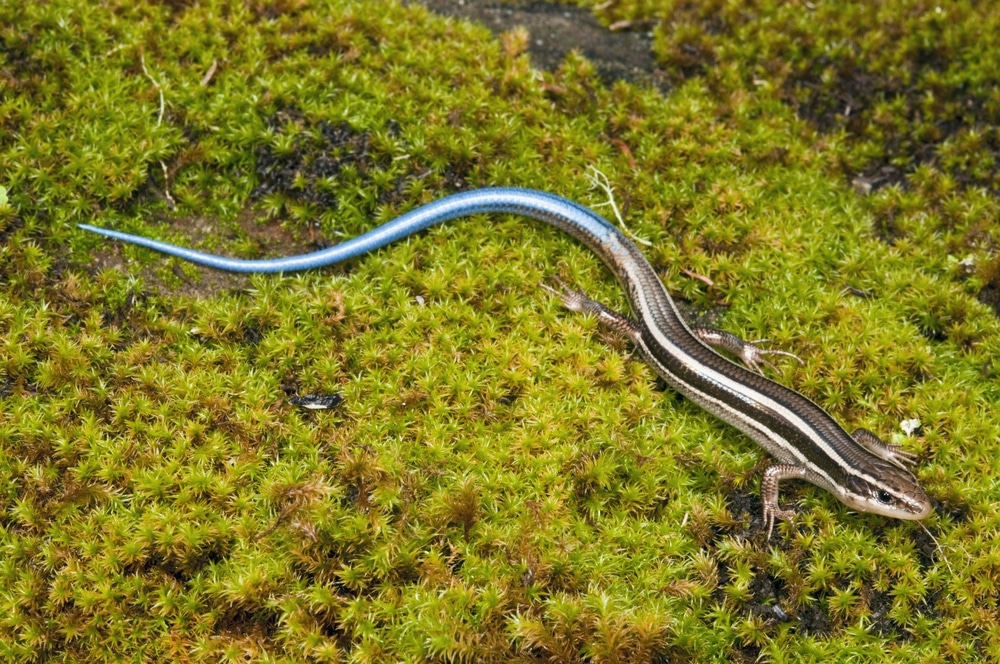
This group includes a huge number of species, including more than 1500 in total. Many of these are either unavailable on the public market or inappropriate for captivity.
There are at least six that make awesome pets for keepers who’re prepared to care for them properly.
We’ll discuss these species below and explain some of the basic facts about them, in hopes that you’ll consider adding one of these species to your reptile collection in the future.
Quick Navigation
Six Types of Skinks That Make Good Pets: Notable Species
There are likely hundreds of skink species that would make good pets, but they’re either poorly known or not available commercially.
Accordingly, keepers interested in skinks will typically want to choose one of the following six species.
1. Blue-Tongued Skink
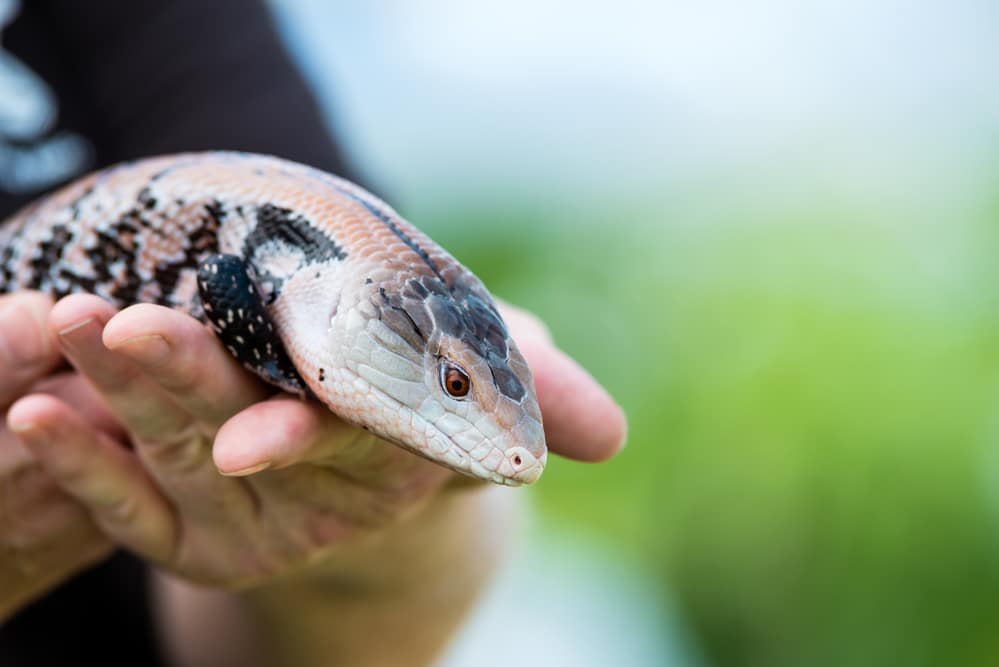
Named for their bright blue tongues that are used in defensive displays, blue tongue skinks (genus Tiliqua) are likely the most popular skinks among reptile keepers, and it is easy to see why: They’re relatively large, they’re typically docile and they are easy to care for. Indeed, blue-tongued skinks are among the best pet lizards in the world – member of the family Scincidae or otherwise.
There are a handful of different blue-tongued skink species available to hobbyists, but they all require broadly similar care.
The group is native to Australia and New Guinea, although they live in a variety of different habitats within this range; some are desert dwellers, while others prefer grasslands or open forests.
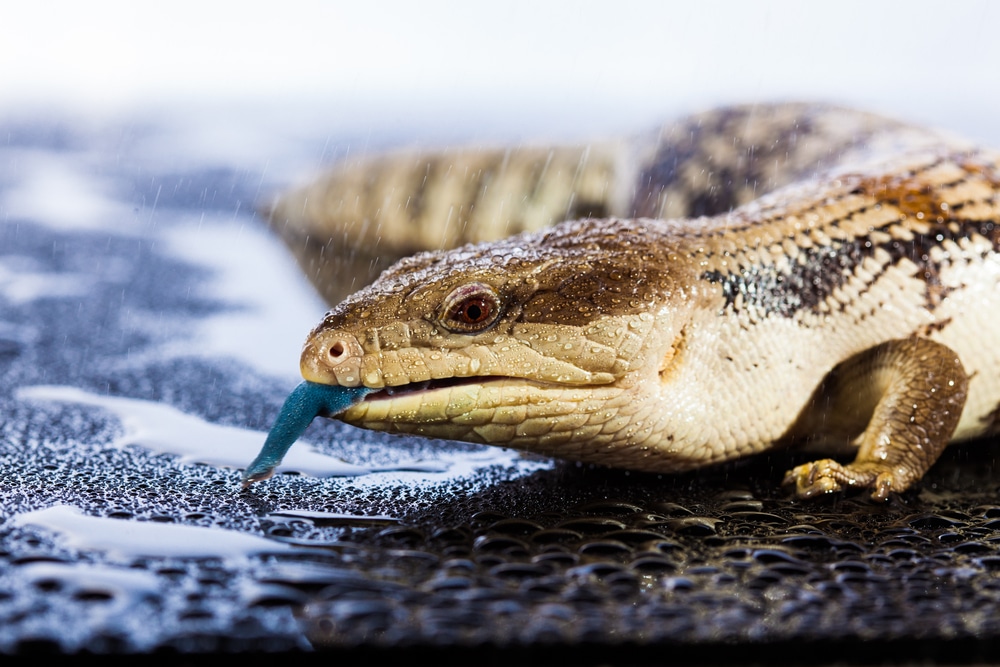
Blue-tongued skinks typically reach about 1 to 2 feet in length. They’re omnivores, who thrive best when provided with a variety of fruits, vegetables and animal matter, including rodents, insects and other invertebrates.
They require warm, spacious enclosures, but they probably do not require full-spectrum lighting, although keepers still debate their light requirements.
2. Schneider’s Skink
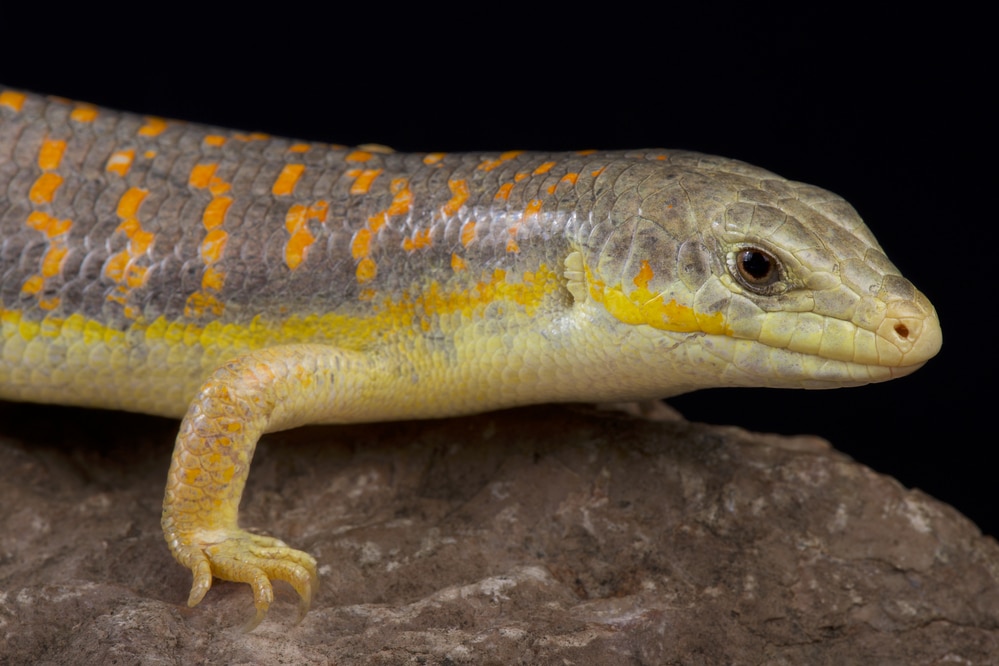
The Schneider’s skink (Eumeces scheiderii) is not as famous as some of the other species discussed here, but it is an interesting species, which can make a fantastic pet for some keepers.
Personally, I think they are underrated among keepers.
Native to a region stretching from Algeria to India, Schneider’s skinks reach about 13 inches in length or so, and they’re fairly heavy-bodied.
They have light-colored ventral surfaces, with brown to grey dorsal surfaces. However, they also bear yellow to orange spots or blotches along their backs, which makes them quite attractive.
Generally speaking, these skinks need the same type of care as most other small skinks from arid lands.
They often thrive in large, dry, brightly lit enclosures with sand substrates and plenty of hiding places. They’ll thrive on an insect-based diet, but these lizards aren’t terribly picky – anything small and wiggly is potential food.
The temperament of Schneider’s skinks varies, but most are relatively flighty at first. This is understandable, as the vast majority available in the pet trade are wild-caught.
However, in my experience, many Schneider’s skinks will calm down over time and accept regular, gentle handling.
3. “Blue-Tailed” Skink
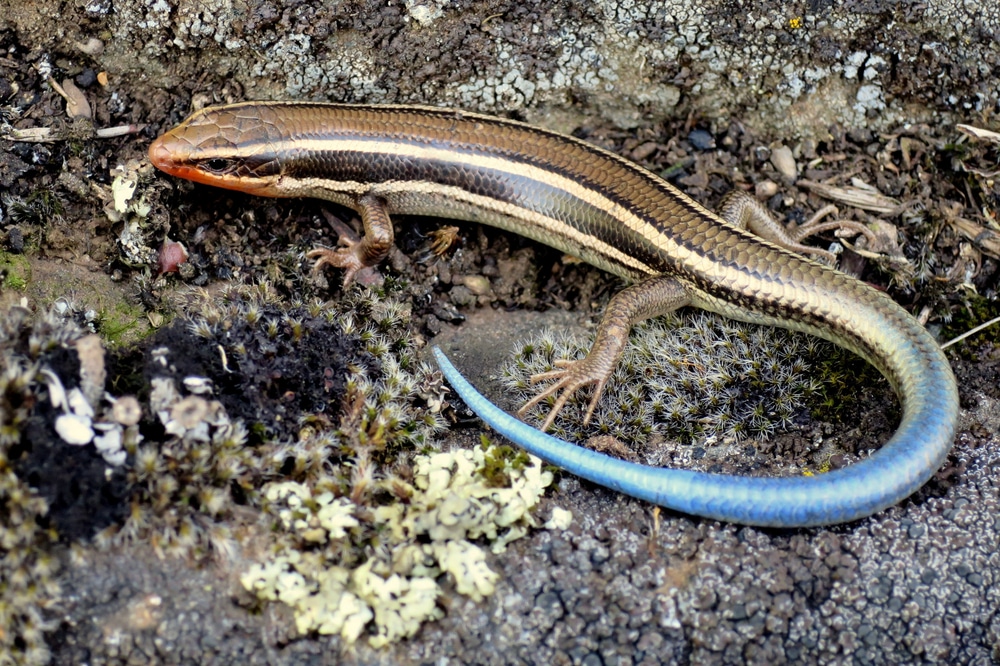
The term “blue-tailed skink” is applied to a variety of skinks, as many bear bright blue tails when they’re young and a handful do so for their entire lives. But for our purposes here, I’m talking about three different species who inhabit the southeastern United States: the five-lined skink (Plestiodon fasciatus), the southeastern five-lined skin (P.inexpectatus) and the broad-headed skink (P. laticeps).
The broad-headed skink grows much larger than the other two (and often predates upon them in the wild) and exhibits some differences in color, pattern and build. But the other two species are remarkably similar; hence the scientific name inexpectatus – scientists didn’t initially appreciate that these were two different species. Only differences in scale counts belied their secret.
Nevertheless, in a broad sense, these lizards are all very similar and require similar things in captivity. They thrive in warm, well-planted enclosures with a variety of hiding places and small basking spots, and they require a primarily insect-based diet.
None become especially tame. They’ll usually flee at their keeper’s approach and bite fiercely (if harmlessly) when captured. But for keepers who enjoy setting up elaborate vivaria, they can make spectacular subjects.
4. Red-Eyed Crocodile Skink
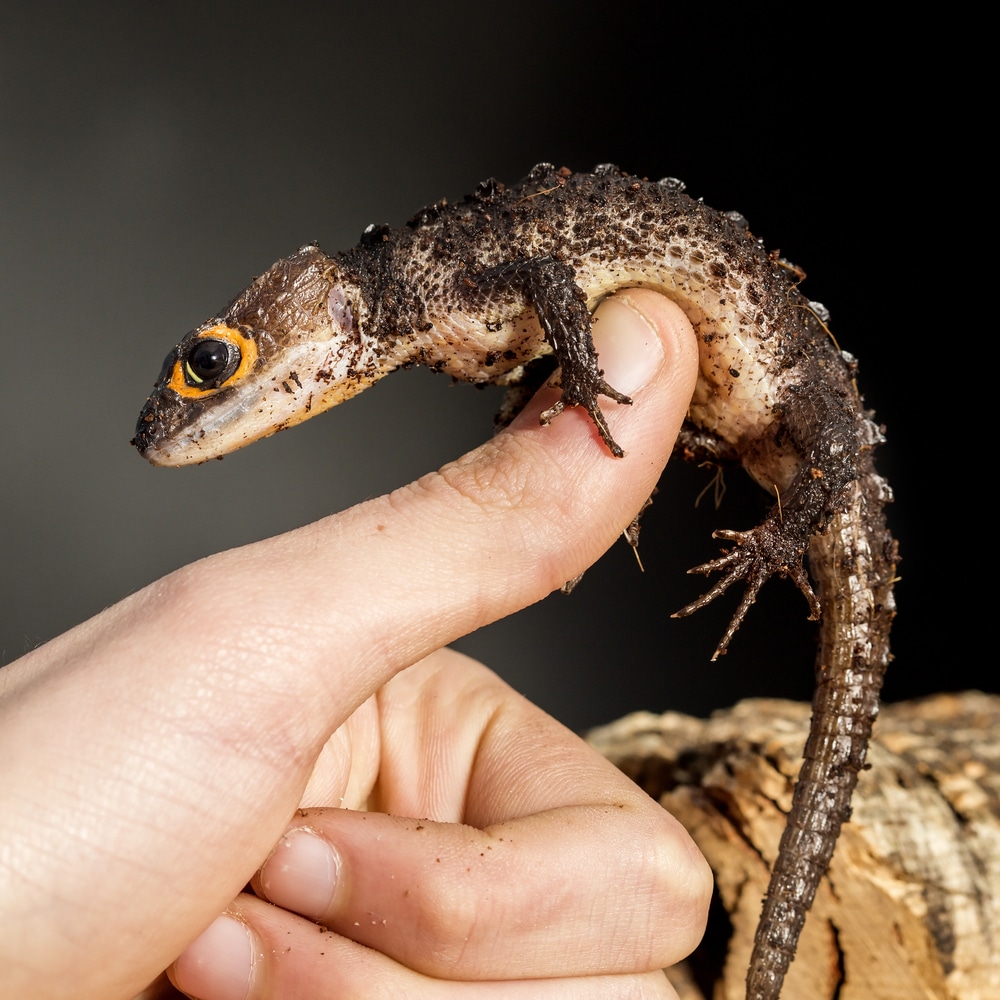
The red-eyed crocodile skink (Tribolonotus gracilis) is a unique, highly armored skink, which is native to the tropical forests of Papua New Guinea.
Easily recognized by its “crocodile-like” appearance, including ridge rows traveling down the back and a helmet-like head, these lizards make an instant impression on any who see them.
Red-eyed crocodile skinks are not particularly common in the pet trade, but hobbyists who wish to keep them should have no trouble finding healthy specimens.
They are also relatively easy to care for!
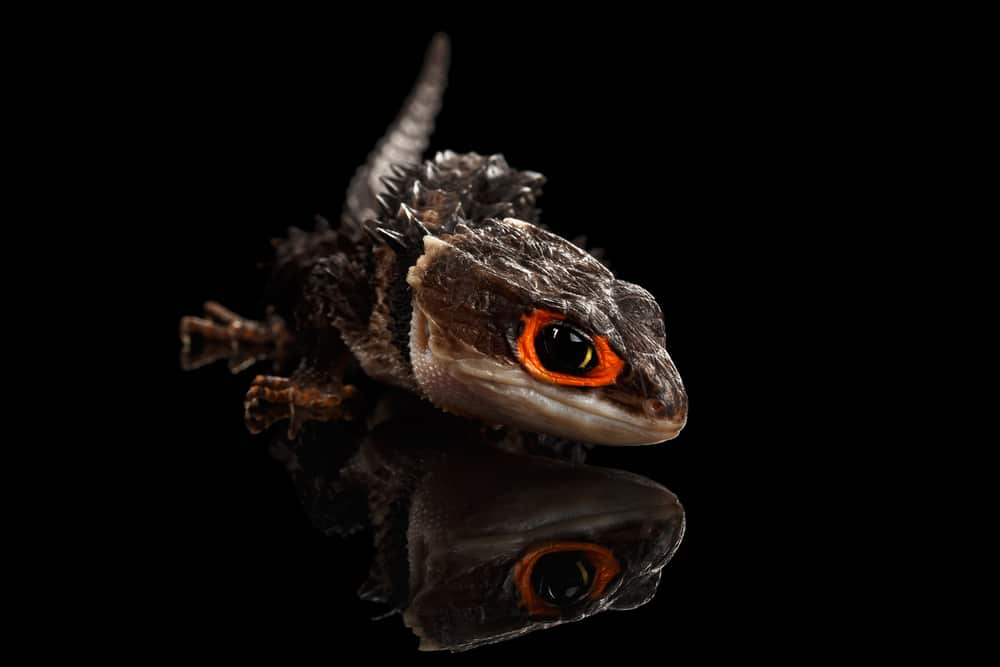
Crocodile skinks require very humid, spacious enclosures, filled with plenty of hiding places and branches to climb. They prefer slightly lower temperatures than many other lizards, with ambient temperatures in the high-70s to low-80s being ideal.
Crocodile skinks tend to be crepuscular (active at dawn and dusk). Accordingly, most keepers refrain from providing full-spectrum lights for this species.
Note that the casque-headed crocodile skink (T. novaeguineae) is also available in the pet trade, although it is less commonly seen than it’s red-eyed cousin.
Both species require broadly similar care.
5. Monkey-Tailed Skink
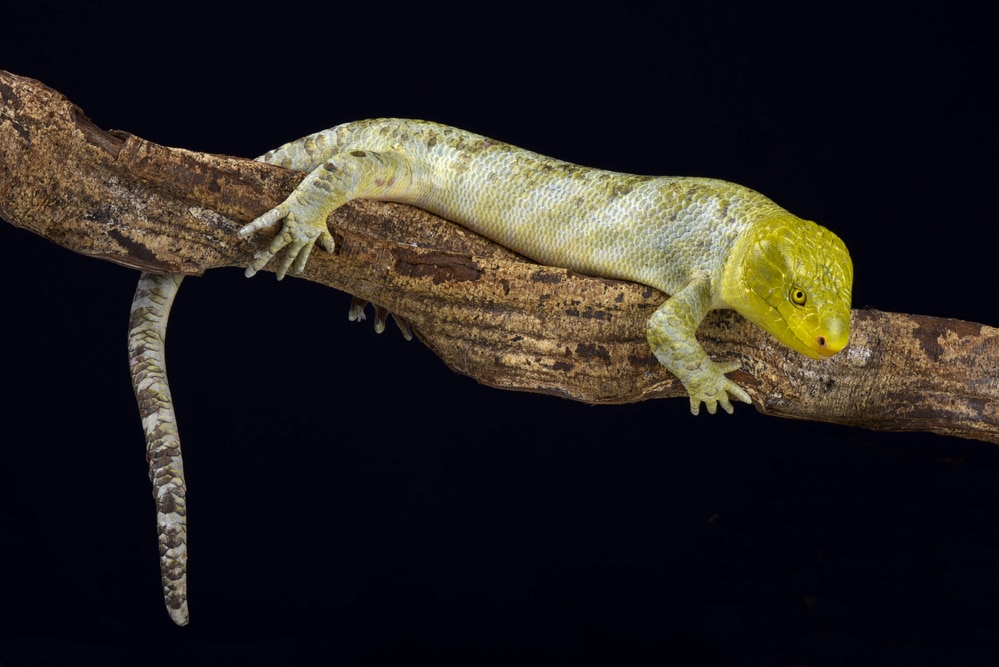
The monkey- or prehensile-tailed skin (Corucia zebrata) is one of the most divergent members of the family Scincidae.
Unlike most other skinks, the monkey-tailed skink is a nocturnal herbivore, who primarily subsists on leaves in the wild.
In captivity, they’ll thrive on a varied diet of typical fruits and vegetables, but you’ll want to be sure to include plenty of dark, leafy greens.
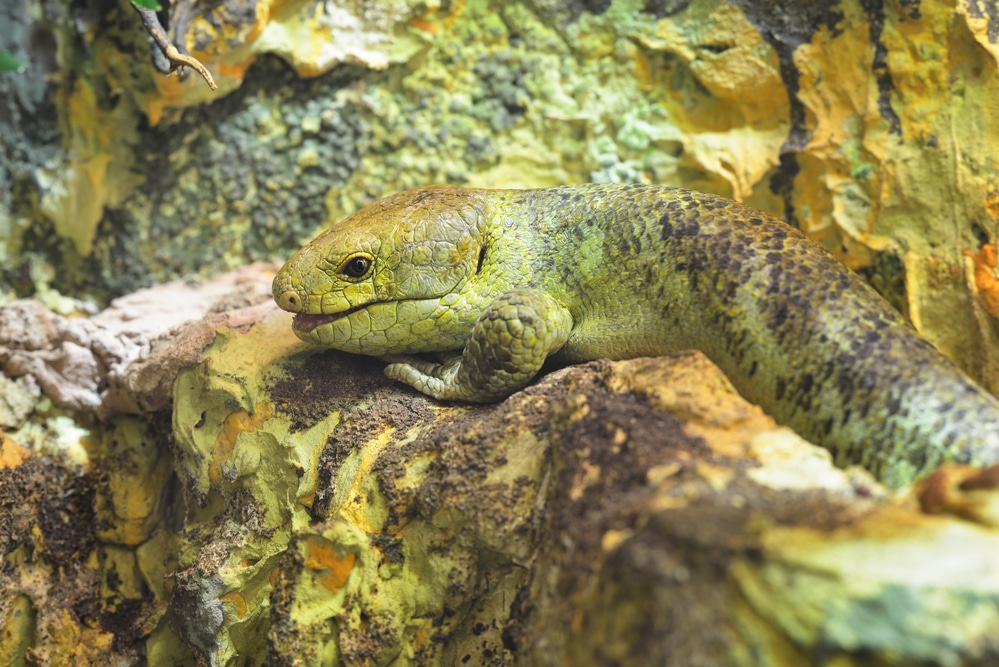
Monkey-tailed skinks are named for their prehensile tail, which helps them grip the trees they inhabit.
In fact, these lizards rarely descend to the ground and prefer to spend most of their time high in the canopy.
Hobbyists who handle their monkey-tailed skink will notice that the lizard frequently uses its tail to “hold on.”
Another unusual trait of the monkey-tailed skink is found in its reproductive biology: These are live-bearing lizards.
Further, these lizards are actually somewhat social, as they live in small groups and are protective of their offspring.
6. Fire Skink
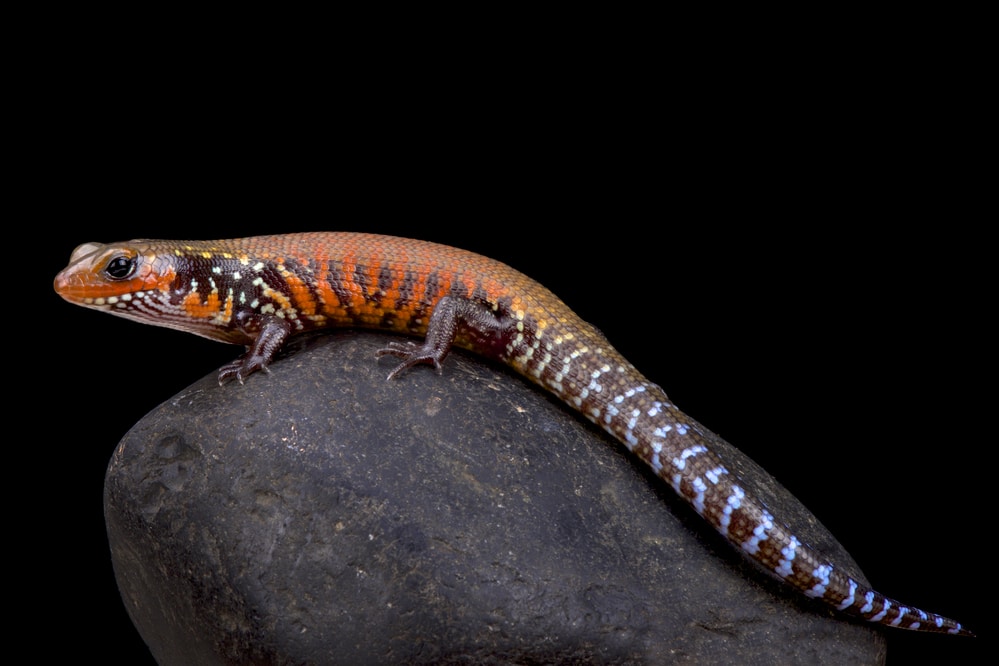
Fire skinks (Mochlus fernandi) are vividly colored lizards, native to West Africa. Clad in a combination of black, red, gold, brown and red, these large skinks (who occasionally reach 15 inches in length) are some of the most visually stunning skinks available to hobbyists.
Unlike some other skinks, in which the sexes differ markedly in color, fire skink males and females are very similar looking.
Fire skinks consume typical skink fare, including insects, soft-bodied invertebrates and smaller lizards.
They require higher humidity levels than many other skinks, and they will thrive best with a deep layer of substrate.
They will climb occasionally, but they aren’t as arboreal as many other skinks.
The majority of fire skinks available in the pet trade are wild-caught, but this species is bred in small numbers.
Beginning hobbyists should make every necessary effort to obtain captive-bred individuals, who’ll almost invariably have a better chance of living long, healthy lives than their wild-caught counterparts.
Pet Skink Biology and Behavior
Despite being a diverse family of lizards, most skinks share several important similarities. This makes skinks somewhat easy to recognize on sight, and it can even help you care for those species that are relatively poorly known.
For example, most skinks have very smooth scales that almost appear “polished.”
Some overlap, which makes the lizards slippery and hard for predators to grip, but a few species have keels (ridges) in their scales, although the reason these species have evolved keels is not understood.
Some skinks have scales that don’t overlap, which gives them a vaguely “beaded” appearance.
Skinks are also relatively similar in terms of size. There are certainly outliers at both ends of the size spectrum, but most are between 6 and 12 inches long.
This means that they all eat roughly similar prey (primarily arthropods and smaller lizards) and must avoid similar predators, such as medium-sized snakes and birds.
While some of the large skink species move pretty slowly, in a calm, deliberate manner, the majority are incredibly quick-moving lizards, who scurry around the habitat at warp speed.
Perhaps not surprisingly, most of these lightning-fast species are diurnal, which gives them the chance to warm up their bodies enough to facilitate reaching these speeds.
Despite these similarities, skink species are found all over the world, and each is uniquely suited to its natural habitat.
They’re found on all continents except for Antarctica, and in a variety of habitats, ranging from forests to fields to deserts.
Picking a New Skink Pet: Things to Think About
Any of the species discussed above may make good pets, but it is important to select one that has the types of traits you want in a pet, as well as care requirements that are easy for you to satisfy. We’ll try to help you do so below.
Do you want a pet you can handle?
Some reptile enthusiasts treat their pets much like aquarists keep theirs – they enjoy them visually, without touching them very often at all. Meanwhile, other keepers enjoy directly interacting with and handling their pets.
Neither approach is intrinsically superior to the other, but you’ll need to keep your approach in mind when picking a new pet skink.
If you don’t need to handle your pets to enjoy them, you can select any of the species discussed above.
However, if you want to handle your pet frequently, you’ll likely be happiest with a blue-tongued skink.
Most individuals are very docile and take keeper interactions in stride. Some monkey-tailed are docile, but others can be a bit nervous and cranky.
Do you want to set up an elaborate vivarium?
You can keep any of the skinks discussed here in “sterile” enclosures featuring paper substrates and only utilitarian cage furniture.
However, this isn’t terribly fun for the hobbyists, and most skinks will thrive better in an elaborate, well-planted vivarium.
Nevertheless, you’ll find it much easier to set up a vivarium for the smaller species discussed above – “blue-tailed” skinks, red-eyed crocodile skinks, fire skinks and Schneider’s skinks – that the two big species.
So, most keepers interested in setting up a natural-looking habitat should stick to the smaller species.
What kind of diet do you want to provide?
Most skinks are carnivores, who primarily feed on insects in captivity.
Insect-eating species are often some of the easiest species for keepers to feed, but the notion of handling live bugs on a daily basis is very off-putting to some keepers.
Fortunately, the monkey-tailed skink is an herbivorous species, who may make sense for bug-averse keepers.
Just be sure that you consider the other facets of monkey-tail skink care before adding one to your family.
How much space do you have available?
While blue-tongued and monkey-tailed skinks can make great pets, they require fairly large enclosures, which will exceed the space many hobbyists have available.
Both species will require enclosures of at least 6 to 8 square feet, and the enclosures for monkey-tailed skinks will need to be relatively tall too.
By contrast, you could likely set up a very attractive enclosure for a few “blue-tailed” or red-eyed crocodile skinks in half this much space, and conceivably less if you maximize the vertical axis of the enclosure (such as by providing elevated climbing branches or subterranean tunnels to increase the amount of floor space available).
Do you want to breed your new pets?
Many reptile-keeping enthusiasts eventually get bitten by the breeding bug and want to try their hand at captive reproduction.
As long as you have the resources to properly care for your breeders and their resulting offspring, there’s nothing wrong with breeding your pets.
But some skinks will make better choices for captive breeding programs – particularly for novices.
Blue-tongued skinks are likely the best choice for keepers interested in breeding their pets. Blue-tongued skinks are widely available in captive-bred form, they often breed readily, and they are live-bearing lizards, meaning that you can side-step the need to incubate eggs.
By contrast, monkey-tail skinks are often quite challenging to breed, while the other species discussed above lie somewhere between these two extremes.
Conclusion
Skinks are a fascinating group of lizards, and many of the group’s members make wonderful pets.
Just be sure that you research the species you intend to maintain before you acquire it, so that you can be sure that you are capable of caring for it properly.
With careful selection and proper preparation, you should be able to give your new pet a long, rich and happy life.